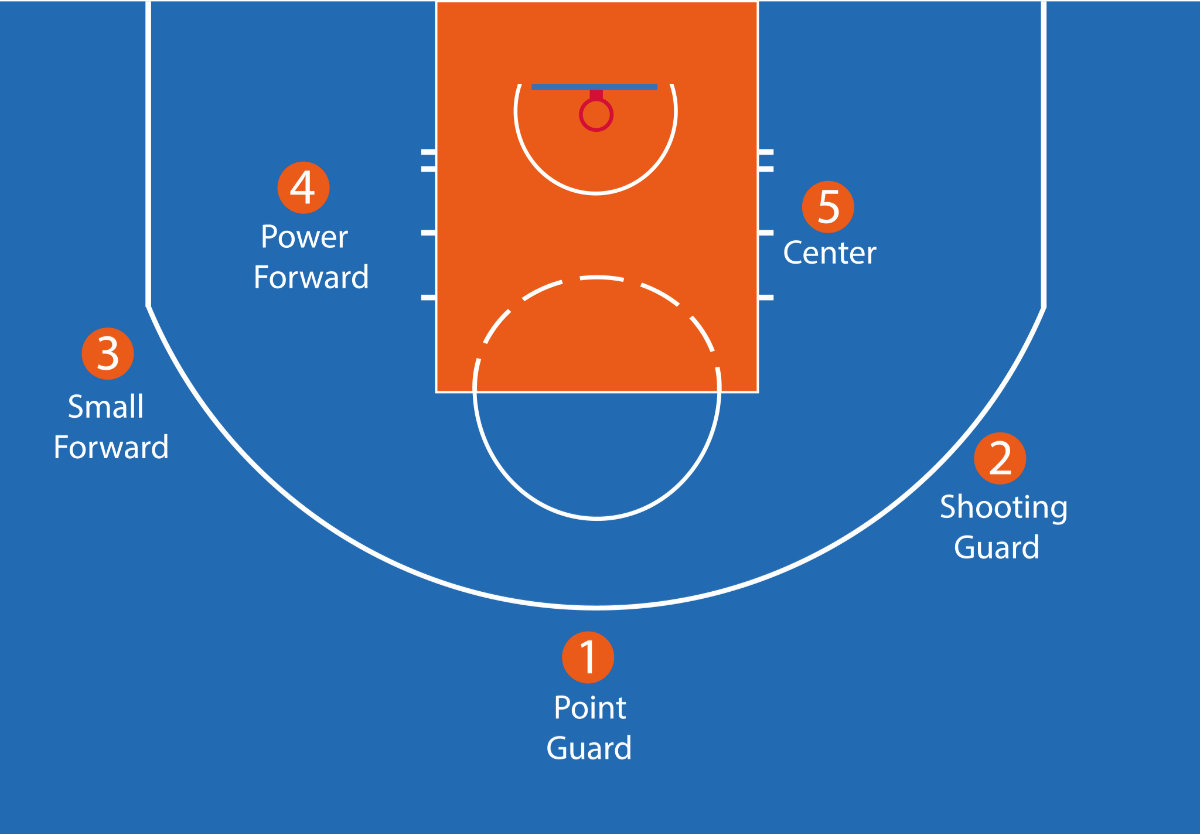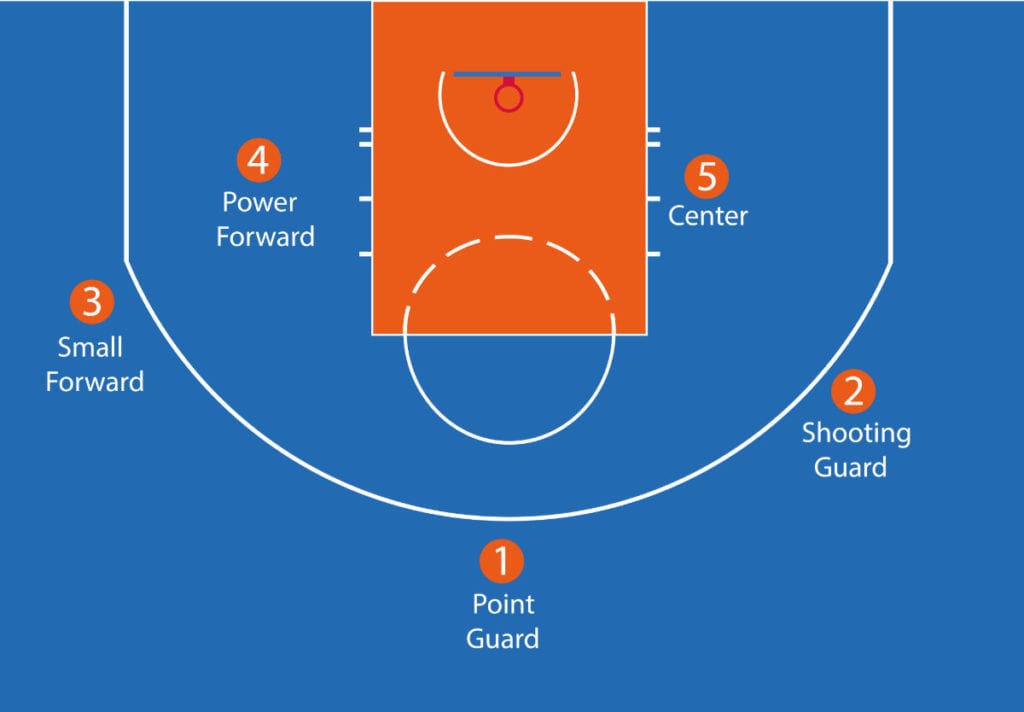
Basketball is a five a side game and although the players are required to move around the court a lot, each player has specific roles and responsibilities by position. Below is a quick guide to the five basic positions and their role in the game which will give new viewers an overview.
Basketball Positions

MrKonstantinos/Shutterstock
Point Guard (PG) “The 1”
The Point Guard (PG) is also known as the one, is typically the team’s best ball handler and passer. Therefore, they often lead the team in assists (passing the ball to a teammate to score) and are able to create openings for themselves. They are usually quick and good at shooting long-range shots – 3 pointers (those scored from outside the 3 point line). Point guards are best described as the playmakers and leaders on the court directing the action and increasing the team’s efficiency They are the ones you see dribbling the ball out after a scoring play or out of bounds turnover.
In Summary
The Point Guard is usually one of the shortest players on the team but is the best ball handler. Also known as the ‘coach on the floor’ or the ‘floor general’, a point guard is responsible for directing plays.
They have good court vision to create open shots for the receivers as well as drive the ball down the court and initiate offensive plays.
Point Guards need to have excellent long-distance shooting abilities, although this is not quite as crucial as for shooting guards.
Some of the Best Point Guards Ever:
Historic
Magic Johnston – 5 NBA Titles & 12 times All-Star
Oscar Robertson (“The Big O”) – 1 NBA Title & 12 times All-Star
Playing in 2019:
Stephen Curry – Golden State Warriors
Chris Paul – Houston Rockets
Russell Westbrook – Oklahoma City Thunder
Shooting Guard (SG) “The 2”
The shooting guard (SG) is also known as the 2 or the off guard. SGs are wing players who usually cover the right side of the Court. As the name suggests, shooting guards are good three-point shooters. Besides being able to shoot the ball, shooting guards tend to be the best defender on the team, as well as being able to move without the ball to create open looks for themselves. Some shooting guards also have good ball-handling skills, often creating their own shots off the dribble. A versatile shooting guard will have good passing skills, allowing them to assume point guard responsibilities known as combo guards. Bigger shooting guards also tend to play as small forwards. In the NBA, shooting guards usually range from 6 feet 4 inches (1.93 m) to 6 feet 8 inches (2.03 m).
Potentially the shortest player on the team, the Shooting Guard is the team’s best outside shooter. Besides being able to shoot well, the Shooting Guard needs to be good at dribbling fast, passing and having court vision by seeing the openings. He is also responsible for driving the ball down the court and setting up offensive plays.
A good Shooting Guard is a huge asset to the team as he’s able to score from virtually anywhere on the court.
Some of the Best Shooting Guards Ever:
Historic
Michael Jordan 6 NBA Titles & 12 times All-Star
Kobe Bryant 5 NBA Titles & 14 times All-Star
Playing in 2019:
Dwayne Wade – Miami Heat
James Harden – Houston Rockets
Small forward (SF) “The 3”
Some of the Best Small Forwards Ever:
The small forward (SF), also known as the three, is considered to be the most versatile of the main five basketball positions. Versatility is key for small forwards because of the nature of their role, which resembles that of a shooting guard more often than that of a power forward. This is why the small forward and shooting guard positions are often interchangeable and referred to as wings.
Small forwards have a variety of assets, such as quickness and strength inside. One common thread among all kinds of small forwards is an ability to “get to the line” and draw fouls by aggressively attempting (post-up) plays, lay-ups, or slam dunks. As such, accurate foul shooting is a common skill for small forwards, many of whom record a large portion of their points from the foul line. Besides being able to drive to the basket, they are also good shooters from long range. Some small forwards have good passing skills, allowing them to assume point guard responsibilities as point forwards. Small forwards should be able to do a little bit of everything on the court, typically playing roles such as swingmen and defensive specialists. In the NBA, small forwards usually range from 6 feet 6 inches (1.98 m) to 6 feet 9 inches (2.06 m)[2].
The Small Forward is usually the shorter of the two forwards on the team but plays in the most versatile role out of the main five positions. He must have enough height and the ability to play on the inside as well as agility to play on the outside, similar to a shooting guard. Small Forwards are usually the second or third best shooters on the team and tend to be able to do a little bit of everything on the court.
Historic:
Larry Bird 3 NBA Titles & 12 times All-Star
Scottie Pippen 6 NBA Titles & 7 times All-Star
Playing in 2019:
Lebron James – LA Lakers
Kawhi Leonard – Toronto Raptors
Power forward (PF) “The 4”
Some of the Best Power forwards Ever:
Historic:
Dirk Nowitzki 1 NBA Title & 14 times All-Star
Charles Barkley 12 times All-Star
Playing in 2019:
Giannis Antetokounmpo – Milwaukee Bucks.
Anthony Davis – New Orleans Pelicans
The power forward (PF), also known as the four, often plays a role similar to that of the center, down in the “post” or “low blocks”. The Power Forward is often the team’s most versatile scorer, being able to score close to the basket while also being able to shoot mid-range jump shots from 12 to 18 feet from the basket. Some power forwards have become known as stretch fours, since in the modern game they have extended their shooting range to include three-pointers.
On defense, they are required to have the strength to guard bigger players close to the basket and to have the athleticism to guard quick players away from the basket. Power Forwards tend to be more versatile than centers since they can be part of plays and are not always in the low block. In the NBA, Power Forwards are usually tall typically in the 6 feet 8 inches (2.03 m) to 7 feet 0 inches (2.13 m) range.
Center (C) “The 5”
The Center (C), also known as the five, usually plays near the baseline or close to the basket (the “low post”). They are usually the tallest players on the floor. The Center usually scores “down low,” or “in the paint” (near the basket), but some can be decent perimeter shooters. They are typically skilled at gathering rebounds, contesting shots and setting screens on plays.
The centre is usually the team’s tallest and strongest player (7 foot plus is the norm) and his favourite position is under the basket. He is also required to be physically domineering with more physical strength than is required for other positions.
On the offensive play, most centres do not consistently score mid-range or beyond the arch. Instead, most of their points should be from offensive rebounds and are also required to block defenders to open other players up for driving to the basket. While on the defensive side of the ball, they are responsible for keeping the opponent from shooting by blocking shots and passes in this vital area. They also fight for rebounds as they’re usually taller and physically more robust.
Traditionally this position was considered one of the most important positions, if not the most important. But due to the scarcity of players possessing the combination of skill, durability and ideal height of late, there has been a move to use players who have more of a power forward game. Still, a good traditional Center is usually the hallmark of a playoff team.
Historic:
Some of the Best Center’s Ever:
Historic:
Wilt Chamberlain 2 NBA Titles 13 times All-Star
Shaquille O’Neil 4 NBA Titles & 15 times All-Star
Playing in 2019:
Joel Embiid – Philadelphia 76ers
Rudy Gobert – Utah Jazz
Sixth Man – The 6
The Sixth Man in Basketball is a player who is not a regular starter but comes off the bench much more often than other non-starters, often being the first player to be substituted in. The sixth man often plays minutes equal to or exceeding some of the starters and posts similar statistics. The presence of a good sixth man is often a sign of a potential Championship winning team and a good indication of the squad’s depth, typically the sixth man is a veteran or fairly recent rookie, talented enough to start for many teams but kept on the bench by the quality of the starting five (think Goran Dragic at Miami or James Harden in his Thunder days). Versatility is a key component of the Sixth Man and he can normally fill in at several positions.
Our personal favourite 6th Man is Lou Williams who has even had a song by Rapper Drake written after him (6 Man). If you don’t mind a bit of bad language you can listen to it below:
6 Man by Drake
Before you go
So there we have it our Five Minute guide to basketball positions and a subjective view of the best players. Anyway, before you go why not join us here at Five Minutes Spare? It only takes a few seconds to sign up and after that why not try a few of our NBA Quizzes – some even offer prizes!

